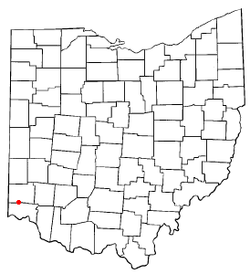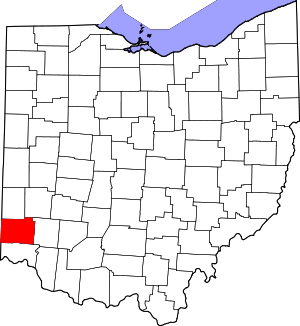Ross, Ohio
Ross is a census-designated place (CDP) in Ross Township, Butler County, Ohio, United States. The population was 3,417 at the 2010 census,[3] up from 1,971 in 2000.
Ross, Ohio | |
|---|---|
.jpg) Venice Pavilion is a prominent landmark in Ross | |
 Location of Ross, Ohio | |
| Coordinates: 39°18′49″N 84°38′42″W | |
| Country | United States |
| State | Ohio |
| County | Butler |
| Area | |
| • Total | 3.14 sq mi (8.14 km2) |
| • Land | 3.12 sq mi (8.07 km2) |
| • Water | 0.03 sq mi (0.07 km2) |
| Elevation | 548 ft (167 m) |
| Population (2010) | |
| • Total | 3,417 |
| • Density | 1,096/sq mi (423.3/km2) |
| Time zone | UTC-5 (Eastern (EST)) |
| • Summer (DST) | UTC-4 (EDT) |
| ZIP code | 45061 |
| Area code(s) | 513 |
| FIPS code | 39-68602[2] |
| GNIS feature ID | 1061628[1] |
History
.jpg)
The settlement was laid out by Dr. Benjamin Franklin Clark on February 1, 1817, as Venus; the spelling later became corrupted as "Venice".[4] Since there was already another post office in the state called Venice,[5] near Lake Erie, this one was renamed in 1834 as Ross.[6]
Geography
Ross is located along the southern border of Butler County at 39°18′49″N 84°38′42″W (39.313606, -84.644899).[7] To the south are the townships of Crosby and Colerain in Hamilton County, including the CDP of Dunlap in Colerain Township.
U.S. Route 27 forms the eastern edge of the CDP, leading south to Cincinnati and north to Oxford. State Routes 126 and Ohio State Route 128 run through the center of Ross as Hamilton Cleves Road. Route 126 splits off to the west toward Brookville, Indiana, while Route 128 continues southwest towards Cleves. The Great Miami River forms the southeastern edge of the CDP.
According to the United States Census Bureau, the CDP of Ross has a total area of 3.14 square miles (8.14 km2), of which 3.12 square miles (8.07 km2) is land and 0.027 square miles (0.07 km2), or 0.85%, is water.[3]
Demographics
.jpg)
As of the census[2] of 2000, there were 1,971 people, 725 households, and 551 families residing in the CDP. The population density was 1,162.8 people per square mile (447.7/km2). There were 753 housing units at an average density of 444.2/sq mi (171.0/km2). The racial makeup of the CDP was 97.97% White, 0.20% African American, 0.36% Native American, 0.20% Asian, 0.10% from other races, and 1.17% from two or more races. Hispanic or Latino of any race were 0.61% of the population.
There were 725 households, out of which 37.8% had children under the age of 18 living with them, 58.9% were married couples living together, 12.0% had a female householder with no husband present, and 24.0% were non-families. 20.1% of all households were made up of individuals, and 8.1% had someone living alone who was 65 years of age or older. The average household size was 2.72 and the average family size was 3.13.
In the CDP, the population was spread out, with 27.1% under the age of 18, 9.3% from 18 to 24, 29.2% from 25 to 44, 22.9% from 45 to 64, and 11.5% who were 65 years of age or older. The median age was 36 years. For every 100 females, there were 93.8 males. For every 100 females age 18 and over, there were 91.3 males.
The median income for a household in the CDP was $41,429, and the median income for a family was $46,354. Males had a median income of $37,463 versus $26,167 for females. The per capita income for the CDP was $18,701. About 4.1% of families and 3.6% of the population were below the poverty line, including 6.5% of those under age 18 and none of those age 65 or over.
References
- "US Board on Geographic Names". United States Geological Survey. 2007-10-25. Retrieved 2008-01-31.
- "U.S. Census website". United States Census Bureau. Retrieved 2008-01-31.
- "Geographic Identifiers: 2010 Demographic Profile Data (G001): Ross CDP, Ohio". U.S. Census Bureau, American Factfinder. Archived from the original on February 12, 2020. Retrieved February 21, 2014.
- Bert Surene Bartlow (1905). Centennial History of Butler County, Ohio. B. F. Bowen. p. 345.
- Overman, William Daniel (1958). Ohio Town Names. Akron, OH: Atlantic Press. p. 137.
- "Butler County". Jim Forte Postal History. Retrieved 21 January 2016.
- "US Gazetteer files: 2010, 2000, and 1990". United States Census Bureau. 2011-02-12. Retrieved 2011-04-23.
